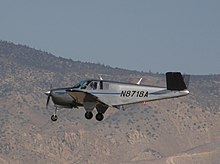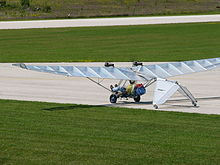



The V-tail or vee-tail (sometimes called a butterfly tail[1] or Rudlicki's V-tail[2][citation needed]) of an aircraft is an unconventional arrangement of the tail control surfaces that replaces the traditional vertical and horizontal surfaces with two surfaces set in a V-shaped configuration. It is not widely used in aircraft design. The aft edge of each twin surface is a hinged control surface called a ruddervator, which combines the functions of both a rudder and elevator.
- ^ Barnard, R.H.; Philpott, D.R. (2010). "10. Aircraft control". Aircraft Flight (4th ed.). Harlow, England: Prentice Hall. p. 275. ISBN 978-0-273-73098-9.
- ^ Gudmundsson S. (2013). "General Aviation Aircraft Design: Applied Methods and Procedures" (Reprint). Butterworth-Heinemann. p. 489. ISBN 0123973295, 9780123973290